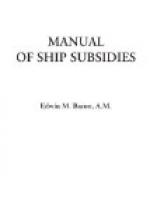The effect of this law appears to have been a division of the interests of shipowners and shipbuilders. The shipowners found the builders constantly increasing their prices until a point was reached where they were accused of absorbing both premiums for construction and navigation, by calculating the amount of bounty which proposed construction would demand, and adding that amount to their cost price.[BW] The increase of the bounty on sailing-ships was made in the expectation that it would check their falling off, which had been rapid since the development of steamship building; merchant sailing-ships were regarded as the best school for seamen, all of whom in French commerce, up to the age of forty-five, are subject at any time to draft into the national navy. It did this and more. There resulted the “strange phenomenon,” as Professor Viallates puts it, “of a steady increase in the sailing-fleet, while the number of steam-ships remained stationary."[BX]
Thus, like its predecessor, unsatisfactory, the law of 1893 was succeeded by another act further enlarging the bounty system. This law was promulgated in 1902 (April 7). It provided three classes of bounty: construction and navigation as before, and “commission compensation” or “shipping premiums.” The construction bounty remained as in previous law. The navigation bounty, now introduced as awarded “as a general compensation for the charges imposed on the merchant navy, and for the excessive cost of vessels built in France,” was increased.[BY] It was payable to all French-built sea-going ships, steam and sailing, of over 100 tons gross, and less than fifteen years old, and was limited to twelve years. To stimulate speed development, only ships showing a trial speed of at least twelve knots with half load were to receive the full navigation bounty; to those making less than twelve knots the bounty was diminished by five per cent; to those making less than eleven, by ten per cent. The shipping bounty was declared to be granted “as compensation for the charges imposed on the mercantile marine” by making merchant vessels practically schools for seamen. It was a “chartered allowance” made to foreign-built iron or steel steamers manned under the French flag for long voyages or for international coastwise trade, of more than 100 gross tons, belonging to French private persons or joint-stock or other companies, the latter having on their boards a majority of French citizens, and the chairman and managers being French. This allowance was reckoned on the gross tonnage, and per day while the steamer was in actual commission (three hundred days the maximum number in any one year).[BX] The rate varied according to the tonnage. Up to 2000 tons gross, it was fixed at five centimes per ton; from 2000 to 3000 tons, at four centimes; 3000 to 4000, three centimes; above 4000, two centimes; over 7000, the same grant as 7000. The creation of this “chartered allowance,” as Professor Viallates explains, was to prevent the navigation bounty from becoming to the same extent as under the previous law merely another form of bounty upon shipbuilding. It could so become, he points out, only to the extent of which it exceeded the owner’s bounty.[BZ]




